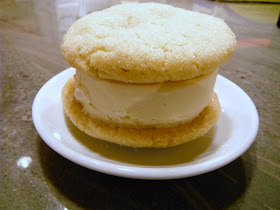
I really wanted to sandwich something today, and I promised I would figure out a way to use up some of the many egg yolks I had hanging out in my fridge.
When I was a kid, my mom would use extra egg yolks to make us a Polish treat called Kogel Mogel. It's basically egg yolks mixed with sugar and sometimes rum *I think*. Hmm...not many people would think of feeding their children a highly-sugared, alcohol-spiked treat made out of raw eggs! But we loved it!
That is NOT what I am going to do with my extra yolks! I'll start with a batch of custard-based ice cream ("French style"), flavor = cinnamon. It's starting to become a little fall-ish outside, which makes me think of cinnamon. But, it's still warm enough to enjoy an ice cream sandwich.
The cookies I decided to make are a variation on a classic sugar cookie recipe that uses yolks only. The recipe is all over the web, called Egg Yolk Cookies. But, that name just sounds unappetizing to me, so I am going to call them resourceful Sugar Cookies!
When both components are done, what we'll have is a Sugar Almond Cookie with cinnamon ice cream sandwich. Sounds yummy, doesn't it?
Ok, let's get started.
The cookie is made using the "Creaming Method." This very popular method of mixing is going to sound familiar to you if you've just about ever stepped foot in a kitchen. I'm going to try to explain, though, WHY it is used.
The method begins with beating a fat (usually butter, but sometimes oil or, for someone other than me, shortening) with sugar. This step is done in order to beat as much air as possible into the batter before the flour is introduced. If you remember from previous posts, agitating/beating flour causes the protein gluten to form, which adds toughness to baked good. But, you can beat your batter all day long on as high a speed as you want before the flour is introduced and there will be nothing going on but more and more air, more fluffiness, more lightness.
The next step is to add in the eggs (or yolks in this case) one by one. This creates an emulsion, which is the combining of fats and liquids. Emulsions take time to form, so give a little time for each egg to be incorporated prior to adding the next. Scraping down the sides helps to further evenly distribute the emulsion and the structural proteins of the eggs.
Any extracts are typically mixed with the liquid (milk for cakes) and then liquids and well-mixed dry ingredients added, alternating and beginning with the dry ingredients. The reason this is done in alternating steps is because you begin to develop gluten as soon as flour is added to the mixture. We do want SOME gluten formation, so the cookies or cake or whatever you are making doesn't fall apart. The gluten formation from the first add of flour is limited because there isn't much liquid in the existing batter. You can mix briefly, then more liquid is added to allow gluten to develop without destroying the emulsion that was created between the fats and the eggs. Limiting gluten formation is also the reason you may see directions tell you to mix only until blended. For a dessert such as a pound cake, where maybe you want a little more structure, you might consider beating the batter on high for a few minutes after everything has been added in order to "develop structure."
For these cookies, there is no real "liquid" other than the egg yolks, so the alternating dry/wet ingredients step is eliminated and the flour is simply added after the yolks and mixed until incorporated.
Almond-Sugar Cookies (*resourceful*)
adapted from Cindy Lynn
makes 30 big cookies
8 oz butter
1 1/2 c sugar
6 egg yolks
2 1/2 c flour
1 t baking soda
1 t cream of tartar
1 t almond extract
Use the creaming method described above. To recap, cream butter with sugar until light and fluffy. Add egg yolks, one at a time, scraping the sides to incorporate. Add extract here since there is no liquid component. Blend dry ingredients together well and add in, mixing just until incorporated. Roll the cookies into small balls (size of golf balls for me), roll in sugar, flatten slightly and bake at 350 F for 8-10 minutes.


Cinnamon Ice Cream
from David Lebovitz
1 c milk
3/4 c sugar
pinch salt
10 cinnamon sticks, broken into pieceso
2 c heavy cream
5 large egg yolks
Warm milk, sugar, salt and 1 c cream in a medium saucepan. Once warm, remove from heat, cover and allow the cinnamon to steep for an hour. Rewarm the mixture, remove the cinnamon sticks with a slotted spoon and discard. Whisk egg yolks then slowly pour the warm milk mixture into the yolks, whisking constantly. Scrape the mixture back into the saucepan and heat until thickened and coats the back of a wooden spoon. This trick for telling the doneness of a custard is known in culinary terms by the French word "nappe," which literally means to completely coat with a light, thin covering. When the ice cream is cooked to proper temperature (160 F), it is known as "nappe," since it will then coat the back of a spoon.
Remove the nappe custard from the heat, and pour through a sieve into a clean bowl with the remaining cup of cream. Cool then freeze in your ice cream maker.

Make sandwiches to eat and enjoy!

No comments:
Post a Comment